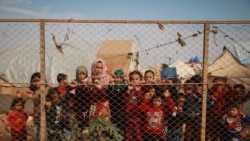On February 12, Brigadier Dirar al-Dandal, the police chief in southern Syria’s Deraa province, said police would continue their efforts to arrest a gang that released an 8-year-old boy, whom it had kidnapped, after receiving a ransom payment.
The kidnapping took place in November 2021, when four men riding motorcycles snatched the boy, Fawaz al-Qataifan, as he was on his way to school. The kidnappers demanded 500 million Syrian liras (about $150,000) for his safe return. His family sold land and asked relatives for money but could raise only half the ransom.
On February 1, the family received a video showing the captors beating the child. The gang threatened to cut off his fingers if they didn’t receive the full ransom.
The video soon found its way to social media, where it went viral and sparked an outcry. The family received support from around the world and was ultimately able to pay the ransom.
Syrian police said they traced the international number that Fawaz’s captors used and arrested a person connected to the gang, but didn’t provide details.
Al-Dandal said the police tried to ambush the kidnappers, but they evaded capture.
“The police did not interfere,” he said, “because our aim [was] to preserve the child's life after the kidnappers threatened to kill him.”
That is false.
After Fawaz was kidnapped, the family reported it to the police, but activists said no serious efforts were made to locate the child. For three months, the family struggled to raise the ransom money. The child was freed only after they paid the captors the ransom.
Al-Dandal’s version of how the boy was released conflicts with the family’s.
He said the boy was left on the outskirts of Nawa town, which are controlled by armed outlaws.
But Fawaz’s father confirmed to Sham FM, a pro-government radio station, that the kidnappers left the child next to a Nawa town pharmacy. Fawaz had a paper on which his family’s name and phone number were written.
A photo of Fawaz sitting in the pharmacy was circulated in the media following his release.
According to the Horan Free League (HFL), a Syrian news portal run by independent journalists, there are several military posts in the area where the police claim the boy was released.
The HFL said it documented 40 abduction cases in Deraa alone in 2021. Most of those involved in the kidnappings operate in Syrian government-controlled areas.
Syria has been devastated by a brutal civil war for more than a decade. The Assad government, with support from Iran and Russia, has regained control of most of the country from rebel groups that held pockets across Syria since 2011. Turkish-backed rebels control northern and northwestern Syria, while Kurdish forces control the northeast.
A United Nations report last year said that close to 90% of Syria’s population is living below the poverty line, with two-thirds in extreme poverty.
“The impact on livelihoods and the gloomy economic prospects pose an even higher risk of individuals joining extremist armed groups and committing crimes,” the U.N. said.
The Syrian Observatory for Human Rights (SOHR), a British monitoring group, said hundreds of children kidnapped since the beginning of the war remain missing in Syria.
Most of the abducted persons were taken for ransom, in some cases for vengeance, SOHR said.
The U.N. estimated in August 2019 that 100,000 people were missing in Syria, the Syrian government is responsible for most of the cases of detained, abducted and disappeared persons.
Deraa is significant as the birthplace of the Syrian civil war. Protests against the regime of President Bashar al-Assad began there in 2011. Demonstrators demanded the release of a group of teenage boys arrested for painting anti-Assad graffiti on the wall of their school.
The protests spread across Syria as security forces responded brutally. More people took up arms, and powers in the Middle East and beyond backed their own proxies.
In 2018, Syrian government forces took Deraa province, and the Free Syrian Army (FSA), which had controlled the area, agreed to a ceasefire brokered by Russia. According to the settlement, the FSA was to hand over heavy weapons in exchange for immunity from arrest.
Some 430 people, mostly FSA members and their families, along with civilians and activists, chose to leave Deraa for Idlib in northwestern Syria, an area still controlled by rebel groups.
The situation remains fragile in Deraa. Local sources say arrests, detentions, kidnappings, torture and killings continue.
In September 2021, U.N. High Commissioner for Human Rights Michelle Bachelet said more than 350,000 people killed in Syria between 2011 and 2021 had been identified, including 26,727 women and 27,126 children. Bachelet added that those numbers were not “final.”
The war has displaced more than 13 million, or half of the Syrian population. Of those, half are displaced inside Syria and the remainder in neighboring countries.







